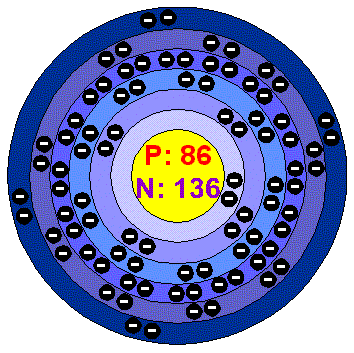|
Radon is colorless at standard temperature and pressure and it is the
most dense gas known. At temperature below it's freezing point is has a
brilliant yellow phosphorescence. It is chemically unreactive, it is
highly radioactive and has a short half life.
Applications
Radon was sometimes used in hospitals to treat cancer and was
produced as needed and delivered in sealed Gold needles. Radon is used
in hydrologic research, because of it's rapid loss to air. It is also
used in geologic research and to track air masses.
Radon in the environment
Radon can be found in some spring water and hot springs. There is
anyway a detectable amount of Radon in the atmosphere. Radon collects
over samples of Radium 226 at the rate of around 0.001 cm3/day per g of
Radium.
Radon occurs in the environment mainly in the
gaseous phase. Consequently, people are mainly exposed to Radon
through breathing air.
Background levels of Radon in outside air are generally quite low,
but in indoor locations Radon levels in air may be higher. In
homes, schools and buildings Radon levels are increased because
Radon enters the buildings through cracks in the foundations and
basements.
Some of the deep wells that supply us with drinking water may also
contain Radon. As a result a number of people may be exposed to
Radon through drinking water, as well as through breathing air.
Radon levels in groundwater are fairly high, but usually Radon is
quickly released into air as soon as the groundwater enters
surface waters.
Exposure to high levels of Radon through breathing air is known to
cause lung diseases. When long-term exposure occurs Radon
increases the chances of developing lung cancer. Radon can only
cause cancer after several years of exposure.
Radon may be radioactive, but it gives of little actual gamma
radiation. As a result, harmful effects from exposure to Radon
radiation without actual contact with Radon compounds are not
likely to occur.
It is not known whether Radon can cause Health effectsin other
organs besides the lungs. The effects of Radon, which is found in
food or drinking water, are unknown.
Radon is a radioactive compound, which rarely
occurs naturally in the environment. Most of the Radon compounds
found in the environment derive from human activities. Radon
enters the environment through the soil, through Uranium and
phosphate mines, and through coal combustion.
Some of the Radon that is located in the soil will move to the
surface and enter the air through vaporization. In the air, Radon
compounds will attach to dust and other particles. Radon can also
move downwards in the soil and enter the groundwater. However,
most of the Radon will remain in the soil.
Radon has a radioactive half-life of about four days; this means
that one-half of a given amount of Radon will decay to other
compounds, usually less harmful compounds, every four days.
|

